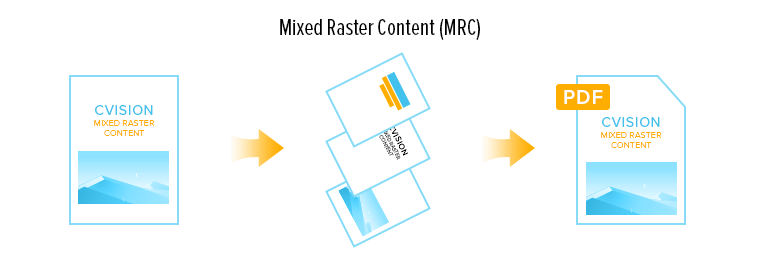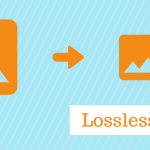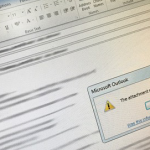Scanned documents are usually efficient to transmit, but large document files can be bothersome as they may be too big to email or so big that downloading it takes minutes or even hours in extreme cases. Any file compression method will reduce the file size of a document. The caveat with compressing files, however, is the trade-off between the quality of the document and the compression amount. Mixed Raster Content (MRC) compression uses algorithms that optimize the quality to compression ratio, making it ideal for compressing PDFs and other image documents.
How MRC Compression Works
Simply downsampling a scanned document reduces its size but also greatly reduces the quality of the images and text within the document—it is a lossy compression. MRC compression provides superior compression by dividing a document into three layers: a binary mask layer, a foreground layer, and a background layer. The binary mask layer is a high resolution black and white layer of text and images. The foreground layer has a lower resolution and consists of text and images. The background layer also has a lower resolution and consists of just images and the background, no text.
Instead of using one algorithm to compress the whole document, MRC compression uses multiple algorithms to compress the separated layers independently. The resulting lossless compressed document consists of the same quality as, or higher quality than, the original document, as well as higher compression compared to other compression technology.
Benefits of MRC Compression
Compressing PDFs and other files with MRC compression increases the efficiency of the document as uploading it, sending it through email, and downloading it is now easier and faster. Compressed documents have the added bonus of being easier to open on mobile, as well. By compressing files with MRC compression, you are reducing the costs of storing documents in the cloud or on local servers. Thus, utilizing file compression reduces an organization’s network bandwidth costs.
CVISION utilizes MRC compression in its PDF Compressor product. In addition to the regular features of MRC compression, PDF Compressor has additional optional functions such as picture detection. When using picture detection, all pictures are in a separate high-resolution layer that undergo an algorithm to maintain the quality of the images.
Furthermore, MRC compression improves the accuracy of OCR (Optical Character Recognition) since the text regions of a document undergo efficient detection algorithms. The resulting compressed PDF can then be fed into a high-volume processing system that uses OCR to render documents machine-readable. Accordingly, organizations can automate their document processing workflow to ensure that their documents are converted to text-searchable PDFs, eliminating the need to have a plethora of software to access the different file types that a document can be saved as. To further enhance the capabilities of compressed and text-searchable PDFs, PDF/A conversion ensures the long-term preservation of vital documentation—another feature of PDF Compressor.
MRC Compression is a superior compression technology that rids your organization of lossy compression qualms. Experience CVISION’s PDF Compressor for yourself to see how MRC, coupled with OCR, optimizes your document processing model for document conversion and archiving.





